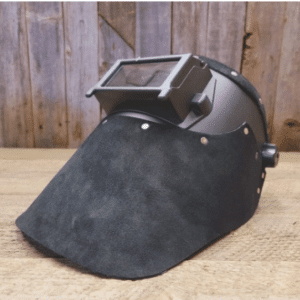Are Leather Welding Helmets Suitable for All Types of Welding?
Welding is a demanding trade, and safety gear is vital for every welder. Among the most critical pieces of equipment is the welding helmet, designed to protect the welder’s face and eyes from sparks, intense heat, and harmful UV radiation. With various options available, many professionals turn to leather welding helmets for comfort, flexibility, and added protection. But are leather welding helmets suitable for all types of welding? Let’s explore their strengths, limitations, and whether they are the right fit for your specific needs.
The Purpose of a Welding Helmet
Before diving into the specifics of leather welding helmets, it’s essential to understand the general purpose of a welding helmet. At its core, a welding helmet is designed to shield the welder’s face and neck from dangerous light emissions, sparks, and debris during welding processes. These helmets also come equipped with protective visors or auto-darkening lenses to prevent eye damage caused by the intense brightness of welding arcs.
What is a Leather Welding Helmet?
A leather welding helmet differs from traditional hard-shell helmets, typically made from materials like fiberglass or thermoplastic. These leather alternatives incorporate durable, heat-resistant leather materials around the face and neck. Leather welding helmets are often chosen for their increased flexibility and comfort, making them a popular choice for welders working in tight spaces or difficult positions.
The appeal of a welding helmet leather option comes from its adaptability. Leather is naturally heat-resistant and offers superior protection from sparks and spatter, ensuring welders stay safe during work. The flexibility of leather makes it an excellent choice for welders who need to move frequently or position themselves at awkward angles. However, this flexibility may also lead to some compromises, particularly in environments requiring more robust head protection.
Types of Welding: Does Leather Work for All?
Welding processes vary, and not all helmets are suitable for every type. Leather welding helmets, while excellent in many cases, may not be ideal for every welding task. Below is a breakdown of how leather welding helmets perform in different welding scenarios:
1. TIG Welding
TIG (Tungsten Inert Gas) welding is known for its precision and control, often requiring welders to work in confined spaces or maintain steady hand movements for extended periods. Leather welding helmets are often favored for TIG welding because they are lightweight, flexible, and comfortable for long durations. The heat protection offered by leather is adequate for TIG welding, which typically doesn’t produce as many sparks as other methods.
2. MIG Welding
MIG (Metal Inert Gas) welding produces a higher intensity of sparks and heat than TIG welding. While leather welding helmets can offer sufficient protection, welders may prefer more rigid helmets in such cases. A solid, hard-shell helmet may provide better durability against the higher levels of spatter and heat that come with MIG welding. That said, leather helmets are still suitable, provided the helmet is paired with proper face and eye protection.
3. Stick Welding
Stick welding, also known as shielded metal arc welding (SMAW), generates significant amounts of heat and spatter. In this case, a more robust, hard-shell helmet might be a safer choice for welders. Leather welding helmets, although heat-resistant, may lack the structural integrity needed to withstand repeated exposure to the intense conditions of stick welding.
4. Flux-Cored Arc Welding
Flux-cored arc welding (FCAW) can create conditions similar to MIG welding, with significant heat, spatter, and sparks. Welders engaged in this type of welding often prioritize maximum face and neck protection. Leather welding helmets can offer adequate protection, but for this intense environment, a more rigid helmet may provide better safety overall.
Benefits of Leather Welding Helmets
Leather welding helmets come with several advantages that make them popular among welders:
- Flexibility and Comfort: Leather is naturally soft and flexible, which provides welders with comfort during long work hours. This comfort is especially beneficial for those working in confined spaces, where rigid helmets can be restrictive.
- Lightweight Design: Leather welding helmets are often lighter than hard-shell alternatives, reducing neck strain. Welders working on projects requiring precision and prolonged attention appreciate this feature.
- Heat Resistance: Leather is inherently resistant to high temperatures, making it ideal for protecting welders from heat and sparks. Leather materials prevent burns and offer excellent protection when working in moderate-heat environments.
- Mobility: Welders often need to change positions quickly or work at odd angles. The flexibility of leather allows for a full range of motion without the helmet feeling bulky or cumbersome.
Potential Drawbacks of Leather Welding Helmets
While leather welding helmets have several benefits, there are some limitations:
- Durability: Leather helmets, though resistant to heat, may not be as durable as their hard-shell counterparts. For welders working in heavy-duty or extremely high-heat environments, a more rigid helmet may be necessary to ensure long-lasting protection.
- Protection Level: In more intense welding environments (e.g., stick or flux-cored welding), the softness of leather might not offer the maximum protection against heavy sparks and flying debris. While leather can handle moderate heat, it may not be sufficient for extreme conditions.
- Limited Use in Certain Welding Types: Leather welding helmets are best suited for light to moderate welding tasks, such as TIG or low-intensity MIG welding. They may not be the best choice for stick or flux-cored welding, where a sturdier helmet would offer better protection.
Should You Choose a Leather Welding Helmet?
The decision to choose a leather welding helmet depends on the type of welding you perform and the level of protection required. If comfort, flexibility, and moderate heat resistance are your top priorities, then a welding helmet leather option could be an excellent fit for your needs. These helmets are especially beneficial for TIG welders and those working in confined spaces. also
However, if your welding tasks involve intense heat, sparks, and spatter—such as with stick or flux-cored welding—you may want to consider a more rigid, durable helmet for maximum protection.
Conclusion: The Right Welding Helmet for Your Job
In summary, leather welding helmets are suitable for many types of welding, particularly when comfort and flexibility are paramount. They offer enough protection for TIG and certain MIG welding tasks, but they may not be the best choice for high-intensity welding processes like stick welding. Always assess your specific needs, the environment in which you work, and the level of protection required before choosing your welding helmet.
To ensure safety and comfort during your welding projects, explore your options and consider pairing leather helmets with high-quality face shields or additional protective gear. For welders seeking flexibility without compromising safety, leather welding helmets remain a practical choice for many types of work.
Contact Us
Ready to find the perfect welding helmet for your needs? Explore our top-rated leather welding helmets designed for comfort, flexibility, and safety. Contact us today to learn more!



